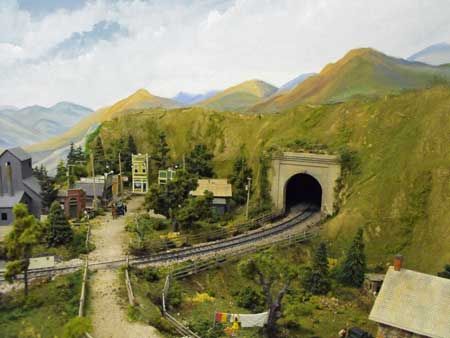History and Culture
HO Scale Detailing Mastery: Elevate Your Model Railroad with Expert Weathering, Realistic Scenery, and Custom Features

Introduction to HO Scale Detailing
For enthusiasts of model railroading, the quest for realism and precision is a never-ending journey. HO scale detailing offers a unique opportunity to bring miniature worlds to life with incredible accuracy. Within the realm of HO scale, which is a 1:87 representation of full-size trains and their environments, detailing is the art of adding the finer touches that make a model railroad truly stand out.
The Art of Weathering Techniques
Weathering is the process of replicating the effects of age and exposure to the elements on trains and structures. It’s a skill that transforms the pristine finish of a model into a story of a well-used and seasoned railway asset. By using a combination of techniques such as dry brushing, washes, and airbrushing, modelers can simulate rust, dirt, and wear that add character to their models. The key is subtlety and the understanding that less is often more when it comes to weathering.
Incorporating Scale Figures
Scale figures breathe life into the scenes you create. These miniature representations of people add scale and context, telling the story of daily life within your railroad. Positioning these figures requires careful thought to create natural and realistic scenes. Whether it’s a conductor checking his watch or passengers waiting on a platform, each figure should have a purpose and add to the overall narrative of your layout.
Crafting Model Railroad Scenery
The scenery on a model railroad is what frames your trains and makes them part of a larger world. Creating realistic hills, valleys, and landscapes requires both creativity and patience. Techniques such as layering foam board, sculpting with plaster, and applying ground cover materials are essential to developing textured and believable scenery. Attention to detail, such as making sure trees are to scale and landscapes match the geography of the region you’re modeling, is crucial.
Creating Realistic Water Effects
Water features, when done correctly, can be a focal point of any layout. Achieving realistic water effects involves using materials like silicone or resin and then tinting and texturing them to mimic the appearance of water. The goal is to replicate the color, movement, and texture of water bodies, whether it’s a calm lake or a flowing river.
Ballasting Tracks
Ballasting is the process of laying stones or gravel around the tracks, just as you’d see on a real railroad. This not only adds realism but also helps to keep the tracks in place. The process involves carefully spreading ballast material around the tracks and then fixing it with a mixture of glue and water. This can be one of the most transformative detailing tasks, instantly making a layout look more professional.
Utilizing Laser-Cut Models
Laser-cut models are a boon for modelers seeking precision and ease of assembly. These kits are cut to exact specifications and can be assembled with a few drops of glue. They offer a high level of detail that can be further enhanced with custom painting and weathering. Buildings, bridges, and intricate structures are all available as laser-cut kits, providing a quick path to adding elaborate details to your layout.
Custom Painting and Decaling
Custom painting and decaling allow for a level of personalization that makes a model railroad unique. This can range from painting your locomotives and rolling stock in the livery of your favorite railroad to applying decals that add specific lettering and numbering. This level of customization is what can set your layout apart and make it truly one-of-a-kind.
Choosing the Right Scale Vehicles
Vehicles are an often-overlooked aspect of detailing that can add significant depth to a scene. From period-correct cars and trucks to service vehicles, each addition should be chosen to fit seamlessly into the era and setting of your layout. These scale vehicles can also be weathered and customized to match the wear and tear you’d expect in a real-world setting.
Enhancing with Model Railroad Lighting
Lighting is a powerful tool in the modeler’s arsenal. It can set the mood of a scene, highlight specific details, or simulate different times of day. From the soft glow of a streetlamp to the bright fluorescence of a factory, lighting adds a dynamic element to layouts that can captivate and mesmerize viewers.
Superdetailing Parts for the Ultimate Realism
Superdetailing is the practice of adding the smallest details that might be overlooked at first glance but collectively contribute to a scene’s authenticity. This could be anything from the bolts on a rail joint to the texture of a brick on a building. These parts are often aftermarket additions that require a steady hand and an eye for detail to install.
In conclusion, HO scale detailing is an intricate and rewarding aspect of model railroading that allows hobbyists to express their creativity and pursuit of realism. By mastering weathering techniques, incorporating scale figures, crafting realistic scenery, creating water effects, ballasting tracks, utilizing laser-cut models, custom painting, choosing scale vehicles, enhancing with lighting, and superdetailing parts, you can transform a simple train set into a captivating miniature world that’s rich with detail and brimming with life. Whether you’re a seasoned veteran or a newcomer to the hobby, the journey of detailing is one that offers endless possibilities and the satisfaction of seeing your miniature world come to life.

Hi there! I’m Timothy Robinson, a 51-year-old male living in Denver, CO, US. As a News Editor for NewsRoomFeed.com, I bring you the latest and most accurate news stories daily. With my degree from UNT, I’ve honed my skills in journalism and storytelling to deliver informative and engaging content to our readers.
But I’m not just all work and no play. Outside of my career, I have diverse interests and hobbies that bring joy and balance to my life. One of my passions is building custom model trains. I spend countless hours in my garage, immersing myself in the creative process of assembling and detailing the intricate train engines. I also construct scale tracks that accurately represent real-world railway systems, complete with miniatures of American Home Town railroad depots and authentic-looking woodland scenery.
You’ll often find me exploring the breathtaking mountains and trails around Denver when I’m not in my garage. Hiking is my way of finding solace in the great outdoors, where I can embrace nature’s serenity and tranquility. From conquering challenging summits to enjoying a leisurely stroll, hiking provides me with the perfect blend of physical activity and mental rejuvenation.
But above all, I value spending quality time with my family. We bond over game nights, embark on exciting road trips, and savor delicious home-cooked meals together. These moments of connection and love create cherished memories that will last a lifetime.
Through my passion for model trains, love for hiking, and devotion to family, I lead a well-rounded and fulfilling life outside my role as a dedicated News Editor. Stay tuned for more as I explore the news world and share my adventures.





